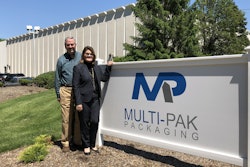For those in the contract packaging/contract manufacturing industry, the Contract Packaging Association’s recently released 2018 State of the Industry Report is something to celebrate. According to the report, the market has been growing at an 11.9% CAGR for the past five years, an astonishing two- to four-times faster than the industries it supports. By 2020, the CPCM market is forecast to break the $75 billion mark—a conservative number, notes the report—rising from $53.6 billion at year-end 2017.
“The 11.9-percent growth is on top of two decades of slightly in excess of double-digit growth,” says Carl Melville, COO of The Melville Group, whose firm conducted the study. “We [CPCMs] are no longer an upstart industry. We’ve been growing at an incredibly fast rate for quite some time.”
The report is based on 100-question interviews with more than 120 CEOs and senior industry executives, with qualitative and quantitative primary and secondary research. Among the areas explored in its 140 pages are industry demographics, the rise of private equity, industry consolidation trends, the labor market, and other topics—all of which present CPCMs with both challenges and opportunities. Note, the report does not include private-label companies, except for those providing specific contract packaging services. The reason, notes Melville, is that the private-label market is so much larger, “it would swamp the boat.”
Melville, it seems, is fond of nautical analogies. His most oft-used expression in discussing the report is “the perfect storm” it depicts. “Something is happening in our industry that has been happening for a while, but it is really, literally coming to a perfect storm this year,” he says. What follows is just some of the data contained within the report that highlights the confluence of trends reshaping the CPCM industry.
Growth opportunities are extensive
In looking at revenue growth for CPCMs, the report breaks the industry down into five categories that include Contract Manufacturing, Food; Contract Manufacturing, CPG; Secondary Packaging; Contract Packaging, Food; and Contract Packaging, CPG (see Figure 1). The largest category is Contract Manufacturing, Food, while the smallest is Contract Packaging, CPG. Based on historic trends, the report predicts these combined core sectors will reach $75 billion in North American revenues by 2020.
Growing at up to four times the rate of the industries they serve, it would seem CPCMs could eventually run into some headspace problems, with no room left to grow. Not so, says the report. In fact, the CPCM industry makes up just 5.8% of the overall food and CPG market (see Figure 2). “So we’re still massively smaller than the industries we serve,” Melville says. “The growth opportunities are extensive.”
One interesting side note Melville shares about the 11.9% growth rate is that “while it sounds like a nice, smooth number, it hides a lot of turbulence under the waves.” Eighteen percent, or one in five CPCMs interviewed, report flat to negative growth. “It doesn’t mean these folks aren’t profitable,” he says. “But they are not growing at the tempo of the times.” Meanwhile, 62% of those interviewed predict continued strong gross margins.
Related to capital expenditures, 90% of those interviewed are increasing CAPEX in 2018, and 38% are committed to increases in 2019 and beyond (see Figure 3). Eighty-one percent report having sufficient or greater access to capital for current organic growth plans.
Looking at regions by volume, the numbers have been steady for years, with the largest U.S. market being the Midwest, followed by the Northeast, the South, and the West, after which are Canada, Mexico, Asia Pacific, and Europe. “The one growth component that has moved quite a bit is Mexico,” says Melville. And, growth in offshore markets is a concern for CPCMs, the study shows, with 22% saying they believe it will be a factor in the next three years. When Mexico is included, that number rises to 46%.
When it comes to company size and scale, there is a large spread. Nearly 20% of respondents are under $5 million in revenue. Many of these are start-ups, while some are small, family-owned concerns. At the other end of the spectrum, 6% of CPCMs are now in excess of $1 billion.
Most interesting, in terms of the perfect storm scenario, is the average age of CPCM owners (with “owners” being the correct terminology, as 94% of businesses in the industry are privately held). Thirty-six percent are aged 56 to 65, typically called “the legacy years.” Sixteen percent are over the age of 66. “So 52 percent of the respondents are at legacy or greater at a time when their business is worth more than it’s ever been worth before,” says Melville. “A lot of these folks have legacy in place. They are family businesses that will pass generationally. But a fair number are going to move into a merger and acquisition mode.”
As growth continues in the CPCM industry, so too does interest by private equity firms in acquiring CPCM businesses—among them those run by owners in their legacy years—and then forming platforms. “They are buying Company A and stacking B, C, and D on top of that to form Company Z, and they are bringing new value to the market,” explains Melville. “When they do, it doesn’t just affect them, it affects everyone in the CPCM industry. I’ve been with private equity folks, and I’ve also run companies that are not, and they are materially different. Platforms are a concern.”
Business development becomes more sophisticated
Business development within CPCM concerns is evolving rapidly and radically due to new market pressures. According to the report, in the past, the owner of the company—in this business and in this category nearly always male—used to be the principle sales agent. Today, the report shows, just 24% of owners/CEOs are the ones primarily responsible for revenue, while 33% of businesses have a small group of key executives who handle sales as well as other activities, and 39% have professional salespeople. (Four percent responded “other.”) As the data shows, the larger a company gets, the more they use professional salespeople.
Why this shift from owner to executive group or dedicated salespeople? Melville says data shows it’s due to the complexity of the sales process, the duration of the process, and the number of people involved on the customer side. He adds that while the quantity of opportunities has grown, leads have not. “People believe they’re being awarded more projects, but they are harder to get,” he adds.
A majority of CPCMs also reported that they will be hiring more salespeople: 59% said they would be increasing their sales force over the next 24 months, 40% said they would stay the same, and just 1% said they would decrease.
The complexity of the sales process has had another impact as well. In the last five years, the number of CPCMs that have adopted CRM (customer relationship management) applications has doubled.
To market their businesses, 52% of respondents said they have implemented e-mail marketing campaigns, although they have not been entirely pleased with the results. Only 12% still purchase leads. “Purchasing leads is usually a sucker’s bet,” says Melville. “It’s very hard to find good ones unless you have the right criteria and know what you’re buying. They tend to be a dead end.”
As for social media, only 15% of respondents have found it to be valuable or effective. “This is a common complaint in and out of the industry,” says Melville. “It’s basically an amplifier. So if you don’t have a sound strategy that suits amplification, you probably shouldn’t be doing it because it can get very expensive and time consuming. And because of that, a lot of members have soured on it.”
Hands down, respondents replied that the most effective strategy to grow their businesses, at 85%, is through networking and personal referrals—a strategy Melville says in this B2B, or “belly-to-belly” business, as he calls it, may never change. “Although some of the other tools and processes and best practices may make that more efficient,” he adds.
Another aspect the report looks at is how CPCMs are measuring customer satisfaction. The old approach of, “Hey Bob, how’re you doing? How’s business?” has been supplanted with more formal processes. Just 38% of respondents reported they view informal communications as the best way to measure satisfaction, while 62% have implemented formal processes, including quarterly meetings (21%), structured evaluation tools (15%), annual top-to-top meetings (14%), and monthly conference calls (12%). This shift is another byproduct of a more complex sales process, where any number of decision-makers may be involved.
Long-term customer relationships grow
The four places new business comes from are 1.) existing business from existing accounts; 2.) new services to existing accounts; 3.) existing services to new accounts; and 4.) new services to new accounts. In 2017, those numbers were 56%, 18%, 18%, and 8%, respectively. The numbers for projected new business sources for 2018 were 41%, 22%, 25%, and 12%, respectively. Summing up the data, Melville observes there’s a fair amount of new service development and new product development going on already, but there will be a significant shift to non-core business in the future.
In understanding services provided (see Figure 4), they run the gamut of primary and secondary activities as well as packaging design and recovery/recycling services. The largest areas are assembly/kitting and fulfillment, bagging and pouching, and wrapping and bundling. The smallest are recovery/recycling, clamshell/blister packaging, and dry blending and filling.
One significant change in the CPCM industry is the preference for turnkey models, which are up 48% to 49%, versus cost-plus models—usually found in secondary packaging operations run by 3PLs—and tolling models, both of which are declining. This is having a positive impact on churn rates, or customer attrition rates, as transactional deals are being replaced by long-term relationships and turnkey pricing. According to the report, today 80% of CPCMs earn more than 60% of their revenue from long-term contracts.
“The bad news is that the hole that blows in your P&L when you do lose a customer is bigger,” says Melville. “Why? Because they are longer revenue streams, they’re larger deals, and they take longer to replace. So while churn is going down, the recipe for reversing churn, bringing in new business, is getting harder and harder to do.”
Consolidation impacts CPCMs, CPGs, retailers
One trend impacting the CPCM industry, which is being played out in three different markets, is M&A activity. As mentioned earlier in relation to private equity’s interest in the CPCM market, M&A numbers in this sector are undergoing a massive sea change, with every year since 2011 setting a new record. According to the report, 24% of respondents indicated there was a 50:50 chance they would be engaging in an M&A in 2018. Almost half said they had received up to five serious M&A inquiries in 2017, with some saying they had received up to 15 to 20 calls, and others getting so many calls they refused to take them anymore.
Ninety percent of those interviewed believe consolidation is speeding up and is going to have an impact—even for those not involved in consolidation. “It matters because now there are bigger competitors, there are foundation businesses, and customers are perhaps looking to reduce their number of suppliers. This may give them more capability to do that,” says Melville. “So this has a lot of implications for all businesses, and it’s happening in a very big way.”
The rise of private equity is driving both consolidation and platform formation, where the platform is funded differently, structured differently, and has things none of the individual components had before. “Is it a competitive threat?” Melville asks. “It’s a competitive change, and companies are responding to it. Independent entrepreneurs may have flexibilities that the platform may not. So it isn’t a win-win, it’s sort of a win-lose.”
Pointing out some of the more notable M&As of late, Melville refers to Goldman Sachs’ billion-dollar investment in the CPCM market four years ago, as well as the recent sale of a co-packer that didn’t exist nine years ago for more than $2 billion.
Driving M&A interest are the unprecedented transaction multiples (a method of looking at past M&A transactions and valuing a comparable company using precedents) being reported—in some cases, multiples of up to 12. Part of that is related to the overall economic climate, Melville relates, while the other part is the strong interest in the growth potential of the CPCM industry.
Another area where consolidation/M&A has been on the upswing is in the Consumer Packaged Goods industry, a trend that 89% of respondents said they believe will have a significant industry impact. This M&A activity includes large brands merging with other major CPGs as well as large CPGs purchasing small start-ups, which have been giving them a run for their money. “The little guys are just kicking these guys’ butts,” says Melville. “They are coming up with gluten-free this and high-protein that, and they’re stripping away all these little pieces of value from the big brands.”
How does this correlate with the consolidation seen in the CPCM industry? Melville says he believes the formation of platforms serves to provide value to the new combined companies and to major CPGs that have acquired small start-ups and need CPCM services to handle the product.
And last but not least, the consolidation of e-commerce and brick-and-mortar—as well as the growth in e-commerce overall—is presenting challenges and opportunities for CPCMs. This Melville categorizes under The Amazon Effect/The Walmart Effect—a trend he says no one has yet figured out, including Amazon and Walmart. “Anyone can ship a book or a computer cable, or deliver a television,” he says. “The question is, how do you handle high-rate, low-volume heavy goods that have to go out constantly, and how do you do that profitably.”
By his estimation, Amazon is closest to figuring this out, and when they do, brands won’t be able to afford not having a seat on the bus. His advice to CPCMs is to continue with account penetration work, so when opportunities in e-commerce arise, “you are at the right place at the right time.”
CPG challenges turned CPCM opportunities
Among the other brand owner challenges noted by the report that present opportunities for CPCMs are the proliferation of stockkeeping units/shorter product life cycles and a reduction in R&D resources, with 53% and 52% of interviewees, respectively, saying they believe these trends will continue to drive change.
The days of a CPG turning on a production line and pumping out the same product and package endlessly are over. In today’s market, CPGs are introducing new product variations to meet consumers’ changing tastes, as well as new package counts, formats, and designs to address different retail channels. One example Melville uses is Oreo, a brand that when he was young had four SKUs. Today, he says, they produce somewhere around 180. These shorter life-cycle, fast-turnaround jobs are exactly the type CPCMs are designed to handle. “They [CPGs] need us,” says Melville.
In addition, as they continue to cut their in-house R&D resources, large CPGs are also looking to CPCMs for innovation, especially as start-up companies begin to nip at their heels, stealing market share from their product lines. Start-up companies don’t have the R&D resources needed either. To capitalize on these opportunities, CPCMs need to ask themselves what services they are bringing to their customers beyond their ability to produce. As Melville relates, he’s seen examples of CPCMs bringing in food scientists and test kitchens, adding pilot lines, and partnering with packaging design firms, among other strategies.
One caveat: Customers are not necessarily willing to write a check for these new services. CPCMs making investments in these areas say it’s just the cost of doing business. The payoff therefore is the customer’s business.
Talent, labor, and human resources
While it may be good news for the U.S. economy, near-zero unemployment is creating big challenges for CPCMs, and 94% believe the problem will not be going away any time soon. Coupled with the labor shortage is another challenge: the growing talent gap. “Eighty-two percent of respondents said they believe the talent gap is getting worse,” says Melville. “It’s harder to find the right people for the open positions CPCMs have or the growth they are anticipating.”
In particular, finding skilled frontline leaders is increasingly difficult. “Frontline operators can make or break a facility, and getting good ones is a never-ending saga,” he adds. “Then you get into specifics like mechanics and quality—areas like that where special certifications and training are an issue. Those vary by company, but there are always shortages in those areas.”
These shortages are expected by 88% of respondents to spur more rapid investments in automation. At the same time, automation suppliers are making these investments increasingly attractive by introducing technology, such as single-touch systems, that require very little skill from operators.
Despite the growing human resource challenges, however, the report shows that 86% of respondents are not willing to loosen their hiring guidelines, a number that Melville says “speaks volumes about the quality of the people in the CPCM industry.”
Beyond working with hiring agencies, which are facing the same problem finding labor, CPCMs are also trying to alleviate labor challenges through career branding, personal networking, and being visible in places where recruits are looking. Another tool that 78% of respondents said they feel would be extremely valuable in addressing the labor shortage and skills gap is an apprentice program. “We as an industry are not doing a very good job of getting out the message that a career in this industry is a good career,” says Melville. “We’re not doing that, and we should be.”
An invaluable business planning resource
Summing up the results of the CPA’s 2018 “State of the Industry Report,” Melville says there is no doubt the CPCM industry is “vibrant, strong, and growing.” But while the future is bright, “it’s not a straight line,” as the trends explored in the report reveal.
The hope of the CPA is that CPCMs—both association members and non-members alike—will use the data to drive success in their companies. Says CPA President Tim Koers, “This report dives into the trends, drivers, and headwinds shaping our industry. It’s an invaluable business planning resource.”
Complete information on the report, including ordering instructions and a downloadable table of contents, is available here. The report is available for $1,995 to non-members and includes one year of access to theState of the Industry Resource Center for a single user. CPA members receive a discount on the report, along with a free Executive Summary.


























